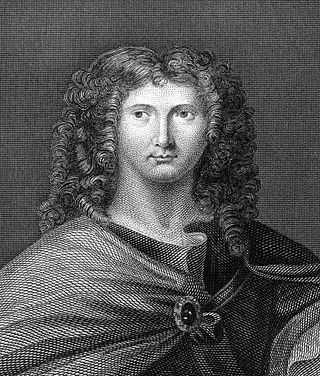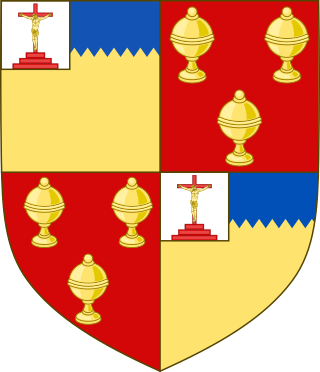Later life
In 1582 in the context of the Composition of Connacht, a surrender and regrant action, Dillon was appointed collector-general of the composition money in Connacht and Thomond. [38] During this period of the English reconquest in Connacht, Dillon was involved in some sharp practices with the local landholders. In particular, he persuaded the various Costello freeholders of the Barony of Costello in eastern County Mayo, to save expense and ensure the smooth legal transfer, to allow him to surrender their lands for them in one land-title in the Surrender and regrant process and had it regranted in his own name, becoming the legal landowner in the process. He never returned this title to the lands to the native owners, which would lead to rapparee actions by Dudley Costello (or Costellogh) against the Dillons in the 1660s.
He fought under the Earl of Essex in the Nine Years' War (1593–1603) and was knighted by him on 24 July 1599. [41] [c] To put this into perspective it should be said that Theobald was already in his sixties and that Essex knighted a great many people and was mocked by saying "he never drew sword but to make knights". [42]
On 19 July 1608, King James I gave him a patent confirming the possession of the manor and town of Kilfaughny in County Westmeath [43] where he then lived and finally died.
On 16 March 1622, King James I created him Viscount Dillon of Costello-Gallen, cementing his legal title. He became the first of a long succession of viscounts Dillon. The territorial designation "Costello-Gallen" refers to the baronies of Gallen and Costello in County Mayo. [44]
Lord Dillon, as he now was, held the title of Lord President of Connaught from c. 1621 on, which he shared with Charles Wilmot, who held that same title from 1616 to 1644. [45]

Earl of Roscommon was a title in the Peerage of Ireland. It was created on 5 August 1622 for James Dillon, 1st Baron Dillon. He had already been created Baron Dillon on 24 January 1619, also in the Peerage of Ireland. The fourth Earl was a courtier, poet and critic. The fifth Earl was a professional soldier, politician and courtier: he was friendly with Samuel Pepys, who refers to him several times as "Colonel Dillon" in his famous Diary. After the death of the tenth Earl, there were two prolonged investigations by the Irish House of Lords during the 1790s to ascertain the legitimacy of his son Patrick, against the rival claim by Robert Dillon, a descendant of the seventh son of the first Earl and the next male heir in line. These eventually found in Patrick's favour. The titles became dormant on the death of the eleventh Earl in 1816. However, in 1828 the United Kingdom House of Lords decided that the rightful heir to the peerages was Michael Dillon, another descendant of the seventh son of the first Earl, who became the twelfth Earl. The House of Lords decided against Francis Stephen Dillon, an inmate of a debtors' prison who dubiously claimed descent from the third son of the first Earl. The titles became extinct on the death of the twelfth Earl on 15 May 1850.

Theobald Dillon, 7th Viscount Dillon of Costello-Gallin supported King James II, was attainted on 11 May 1691, and fell in the Battle of Aughrim during the Williamite War. His attainder was reversed in favour of the 8th Viscount on 20 June 1694.

Lucas Dillon, 6th Viscount Dillon was an Irish peer who recovered title and lands after the restoration of King Charles II.

Henry Dillon, 8th Viscount Dillon was an Irish soldier and politician. In 1689 he sat in the Patriot Parliament. He fought for the Jacobites during the Williamite War, defending Galway against Ginkel and surrendering it in 1691 after a short siege. He obtained the reversal of his father's attainder in 1696 recovering his father's lands.

Charles Henry Dillon-Lee, 14th Viscount Dillon (1810–1865), was an Irish and English landowner. He lived in Ditchley, Oxfordshire, England, and was represented in Ireland by his agent Charles Strickland.

Thomas Dillon, 4th Viscount DillonPC (Ire) held his title for 42 years that saw Strafford's administration, the Irish Rebellion of 1641, the Irish Confederate Wars and the Cromwellian Conquest of Ireland. He was a royalist and supported Strafford and Ormond. He sided with the Confederates for a while but was a moderate who opposed Rinuccini, the papal nuncio.
Sir James Dillon was an officer in the armies of the Irish Confederate Catholic during the Irish Confederate Wars (1641–53) and an MP for County Westmeath in the Irish House of Commons. He was likely born at Kilfaughny, Athlone and lived in the vicinity.
Sir Roger Jones, 1st Viscount RanelaghPC (Ire) was joint Lord President of Connaught with Charles Wilmot, 1st Viscount Wilmot. He commanded the government forces in Connaught during the Irish Rebellion of 1641 and the beginning of the Irish Confederate Wars defending Athlone against James Dillon until February 1643.
Sir James Dillon, 3rd Earl of Roscommon was an Irish magnate and politician. He was born a Catholic but converted at a young age to the Church of Ireland. He supported Strafford during his term as governor of Ireland. In the Confederate Wars and the Cromwellian conquest he was a royalist. He died in 1649, but was nevertheless included as the fifth on the list of people that were excluded from pardon in Cromwell's 1652 Act of Settlement.

Sir Theobald Butler, 1st Baron Cahir, Caher, or Cahier was the first baron Cahir of the second creation, which occurred in 1583.
Richard Butler of Kilcash was an Irish soldier and landowner, the third son of Thomas Butler, Viscount Thurles and brother of James, 1st Duke of Ormonde. He sided with the Irish Confederacy at the Irish Rebellion of 1641. He scouted the enemy on the morning of the Battle of Cloughleagh. His descendants succeeded to the earldom of Ormond when the senior branch of the family failed in 1758.

Colonel Thomas Butler of Garryricken, also known as Thomas Butler of Kilcash was an Irish Jacobite soldier. He commanded a regiment, Thomas Butler's foot, during the Williamite War and fought at the Battle of Aughrim in 1691 where he was taken captive. His son John would, de jure, become the 15th Earl of Ormond.
Sir Robert Dillon of Riverston was an Irish lawyer, judge, and politician. He came from a family with a distinguished record of judicial service. He pursued a successful career as a judge, which was, however, dogged by accusations of corruption and other serious wrongdoing, of which the worst was that he had falsely condemned Nicholas Nugent, another judge and rival, to death. Sir Robert Dillon, the subject of this article, must not be confused with an earlier Sir Robert Dillon of Newtown, his grand-uncle, who was also Chief Justice of the Irish Common Pleas.
Sir Bartholomew Dillon was a leading Irish judge of the sixteenth century who held the offices of Chief Baron of the Irish Exchequer and Lord Justice of Ireland.

Elizabeth Poyntz (1587–1673), known as Lady Thurles, was the mother of the Irish statesman and Royalist commander James Butler, 1st Duke of Ormonde.
James Dillon, 1st Earl of Roscommon fought for the crown in the Nine Years' War. He was ennobled despite being a Catholic after his son Robert turned Protestant.
Robert Dillon, 2nd Earl of RoscommonPC (Ire) was styled Baron Dillon of Kilkenny-West from 1622 to 1641 and succeeded his father only a year before his own death. He supported Strafford, Lord Deputy of Ireland, who appointed him keeper of the great seal. Dillon was in December 1640 for a short while a lord justice of Ireland together with Sir William Parsons.
Sir Robert Dillon of Newtown near Trim was an Irish judge of the Tudor era. He served as Chief Justice of the Irish Common Pleas for more than twenty years, despite repeated calls for his removal on the grounds of age and ill health.
Luke Plunket, 3rd Earl of Fingall (1639–1684) was an Irish soldier and politician. He was one of the signatories of the Catholic Remonstrance of 1661.
Sir Lucas Dillon of Loughglynn (1579–1656) was in 1628 one of the negotiators of the Graces; he was MP for Roscommon in the two Irish Parliaments of Charles I. At the Irish Rebellion of 1641 he sided with the rebels and joined the Irish Catholic Confederation, where he served on the Supreme Council.







